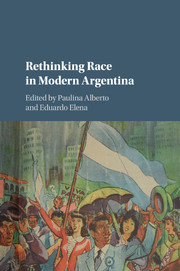Book contents
- Frontmatter
- Contents
- List of figures
- List of tables
- Notes on the contributors
- Preface
- Introduction: The shades of the nation
- PART I HISTORIES OF RACE IN THE TWENTIETH CENTURY
- 1 Insecure whiteness: Jews between civilization and barbarism, 1880s–1940s
- 2 People as landscape: The representation of the criollo Interior in early tourist literature in Argentina, 1920–30
- 3 Black in Buenos Aires: The transnational career of Oscar Alemán
- 4 La cocina criolla: A history of food and race in twentieth-century Argentina
- 5 “Invisible Indians,” “degenerate descendants”: Idiosyncrasies of mestizaje in Southern Patagonia
- 6 Race and class through the visual culture of Peronism
- 7 Argentina in black and white: Race, Peronism, and the color of politics, 1940s to the present
- PART II RACE AND NATION IN THE NEW CENTURY
- Epilogue: Whiteness and its discontents
- Collective bibliography
- Index
4 - La cocina criolla: A history of food and race in twentieth-century Argentina
from PART I - HISTORIES OF RACE IN THE TWENTIETH CENTURY
Published online by Cambridge University Press: 05 March 2016
- Frontmatter
- Contents
- List of figures
- List of tables
- Notes on the contributors
- Preface
- Introduction: The shades of the nation
- PART I HISTORIES OF RACE IN THE TWENTIETH CENTURY
- 1 Insecure whiteness: Jews between civilization and barbarism, 1880s–1940s
- 2 People as landscape: The representation of the criollo Interior in early tourist literature in Argentina, 1920–30
- 3 Black in Buenos Aires: The transnational career of Oscar Alemán
- 4 La cocina criolla: A history of food and race in twentieth-century Argentina
- 5 “Invisible Indians,” “degenerate descendants”: Idiosyncrasies of mestizaje in Southern Patagonia
- 6 Race and class through the visual culture of Peronism
- 7 Argentina in black and white: Race, Peronism, and the color of politics, 1940s to the present
- PART II RACE AND NATION IN THE NEW CENTURY
- Epilogue: Whiteness and its discontents
- Collective bibliography
- Index
Summary
In 1889, an Italian visitor to Santiago del Estero praised the liberal “progress” sweeping this Northwestern provincial capital. He celebrated the new market, buzzing commercial center, and renovated homes filled with products from Europe and Buenos Aires. He emphasized his appreciation for the renovated kitchens that, in his view, “reveal[ed] a step forward in the manner of eating.” Citing writer Brillat-Savarin's famous aphorism ‘tell me what you eat and I will tell you what you are,’ he argued that this new manner of cooking and eating among the santiagueño elite embodied “true progress.” Even in this relatively sleepy city far from the national capital, cosmopolitan culinary practices had recently begun to have a marked impact. While our visitor did not specify the exact nature of the foods consumed, in Santiago, as in Buenos Aires and Córdoba, it was likely French fare or at least local dishes dressed up with French names and served at elegant, well-set tables.
The question of who Argentines were as well as what and how they should eat received a considerable amount of attention during the late nineteenth century and throughout the twentieth. Around the turn of the century, many Argentine scientists and politicians embraced a version of Lamarckian eugenics that held that changing a combination of biological and environmental factors, including people's diets, would improve the population. Given the association of French cuisine with high civilization across the Americas, Argentine elites (like their counterparts in Mexico or Brazil) publicly embraced French dishes to cement their own respectability and that of their nation. At the same time, in more private, quotidian settings, they also enjoyed specialties with local ingredients and techniques.
As massive numbers of immigrants – most from Italy and Spain – made their way to Argentina around the turn of the century, they shaped new ideas about what defined Argentine food. Even today, most urbanites describe Spanish and Italian influences as particularly prominent in the development of a national cuisine. As one elderly gentleman of Italian descent explained to me in Buenos Aires in 2003, “Here the main influence [on food] is Spanish and Italian […] After that there are evidently other influences.” Such notions about the roots of Argentine cuisine parallel racial ideologies that held that the massive wave of immigrants had displaced earlier Indo-Afro-Hispanic society and its legacies.
- Type
- Chapter
- Information
- Rethinking Race in Modern Argentina , pp. 99 - 125Publisher: Cambridge University PressPrint publication year: 2016
- 3
- Cited by



